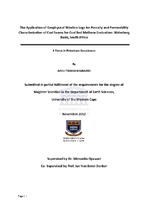| dc.contributor.advisor | Opuwari, Mimonitu | |
| dc.contributor.advisor | Van Bever Donker, Jan | |
| dc.contributor.author | Nimuno Teumahji, Achu | |
| dc.date.accessioned | 2016-06-27T12:14:25Z | |
| dc.date.available | 2016-06-27T12:14:25Z | |
| dc.date.issued | 2012 | |
| dc.identifier.uri | http://hdl.handle.net/11394/5104 | |
| dc.description | >Magister Scientiae - MSc | en_US |
| dc.description.abstract | The fracture porosity and permeability of the Beaufort Seam 1 (BS1) and Ecca coal seams of the Waterberg Basin have been comprehensively characterised with the aid of geophysical wire‐line logs. The main aim of the thesis was to estimate the porosity and permeability of the coal seams using down‐hole wire‐line data; comparing results from injection falloff test to establish the validity of the technique as a fast an effective method. The study area is the largely under explored Karoo‐aged, fault bounded Waterberg basin Located in the Limpopo Province of South Africa. The study employed mainly the density and dual lateral resistivity logging data (Las format) from eight wells (WTB45, WTB48, WTB56, WTB58, WTB62, WTB65, WTB70 and WTB72). Density logging data was used for coal identification and fracture porosity estimation while fracture permeability was estimated from dual lateralog resistivity data. Analysis of fracture porosity required coal cementation indices and fracture width as an input parameter. These were estimated with the aid of water pump out test data, coal quality and gas analysis data provided by Anglo Coal in addition to the above mention logs. The collection of sheet coal model was used to represent anisotropic coal reservoirs with
non‐uniform fracture system was used to represent these coals. The mathematical formulas used to estimate both fracture porosity and permeability took into account the above coal model. The theoretical formulas are a modification from both Darcy’s equation and Archie’s equations. The coal seams were encountered at depths ranging from 198m to 385m in the wells and were marked by low density and very high resistivity. From the estimated results the coal reservoirs are characterised by high cementation indices ranging from 0.82 to 2.42, very low
fracture porosity and low fracture permeability. Estimated results show that coal reservoir fracture porosity ranged from 0.0002% to 0.33% for both BS1 and Ecca seams. Estimated results also show that coal reservoir permeability ranged from 0.0045mD to 6.05mD in the BS1 formation and from 0.01 to 0.107mD in the Ecca. Results when compared with those of injection falloff test shows that the estimated permeability is slightly lower as expected since the model did not account for coal anisopropy. The fracture permeability was found to decrease with increase in vitrinite content, coal rank, coal burial depth and increases with increase in inertinite content. On a basinal scale the model estimated permeability was found to increase slightly from the east to the west of the basin. The porosity decreases
with increase cementation index for deeper coal seams and increases with increase
cementation index for shallower coal seams. | en_US |
| dc.language.iso | en | en_US |
| dc.publisher | University of the Western Cape | en_US |
| dc.subject | Geophysical wireline logs | en_US |
| dc.subject | Coal seams | en_US |
| dc.subject | Waterberg Basin | en_US |
| dc.subject | Porosity | en_US |
| dc.title | The application of geophysical wireline logs for porosity and permeability characterisation of coal seams for coal bed methane evaluation : Waterberg Basin, South Africa | en_US |
| dc.type | Thesis | en_US |
| dc.rights.holder | University of the Western Cape | en_US |

